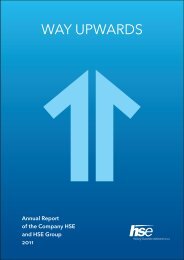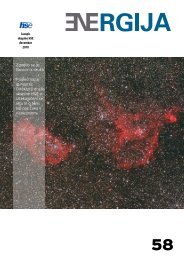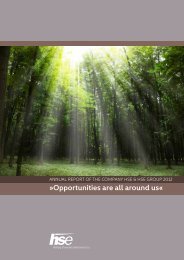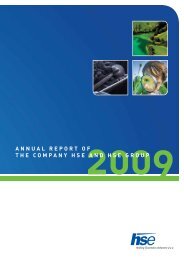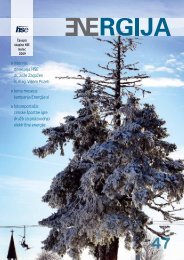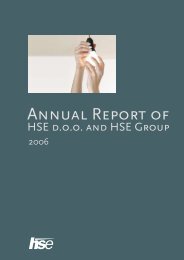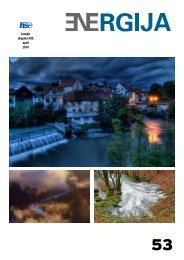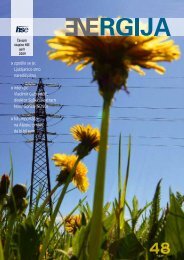ANNUAL REPORT - HSE
ANNUAL REPORT - HSE
ANNUAL REPORT - HSE
You also want an ePaper? Increase the reach of your titles
YUMPU automatically turns print PDFs into web optimized ePapers that Google loves.
Intangible assets and long-term<br />
accrued revenue and deferred<br />
costs<br />
Intangible assets represent a part of fixed assets enabling<br />
the performance of the companies’ registered<br />
activities, while physically they do not exist.<br />
Intangible assets are initially recognised at cost, which<br />
is also comprised of duties and all costs incurred<br />
while preparing an asset for its intended use. Interest<br />
on loans for the acquisition of intangible assets is not<br />
considered as part of the cost.<br />
After initial recognition, intangible assets are measured<br />
using the cost model.<br />
An item of intangible assets with finite useful life is<br />
amortised using the straight-line amortisation method.<br />
Amortisation begins when the intangible asset is<br />
available for use. The residual value of intangible assets<br />
has not been determined.<br />
In the bookkeeping records the cost and accumulated<br />
amortisation of intangible assets are recorded separately,<br />
whereas in the consolidated balance sheet they<br />
are recorded at carrying amount, i.e. as a difference<br />
between the cost and accumulated amortisation.<br />
An item of property, plant and equipment is initially recognised<br />
at cost. The cost comprises its purchase price,<br />
import duties and non-refundable purchase taxes, and<br />
any directly attributable costs of bringing the asset to<br />
working condition for its intended use, especially the<br />
costs of transportation and installation. The cost does<br />
not include the costs incurred upon the dismantling or<br />
refurbishment of property, plant and equipment.<br />
At one of the subsidiaries the cost is also increased<br />
by the amount of interest on loans taken out to acquire<br />
an item of property, plant and equipment until<br />
the item is ready for use.<br />
The cost of an item of property, plant and equipment<br />
constructed or manufactured within the Group consists<br />
of the costs incurred as a result of its construction or<br />
manufacturing and of indirect construction or manufacturing<br />
costs that can be attributed to the item.<br />
The cost of items of property, plant and equipment of<br />
greater value is divided into individual items with different<br />
useful lives.<br />
The spare parts of higher value are recorded as property,<br />
plant and equipment and depreciated over the<br />
useful life of the related asset.<br />
On disposal, intangible assets are eliminated from the<br />
books of account, and the difference between the net<br />
sales value and the carrying amount of a disposed of<br />
intangible asset is transferred to revaluation revenue<br />
or expenses.<br />
Goodwill occurs in consolidation as a result of the<br />
cost of an acquired interest in a company that is higher<br />
than the value of this interest in the equity of such<br />
a company. Goodwill is not amortised. It is impaired if<br />
necessary.<br />
Long-term accrued revenue and deferred cost items<br />
relate to long-term deferred costs that are initially<br />
recognised at cost but are later written down as part<br />
of costs to which they belong.<br />
Property, plant and equipment<br />
Property, plant and equipment are part of long-term<br />
assets owned by group companies and used for the<br />
performance of their registered activities.<br />
The anticipated costs of regular inspections and repairs<br />
of property, plant and equipment are considered<br />
as parts of property, plant and equipment.<br />
After initial recognition, the items of property, plant<br />
and equipment are measured using the cost model.<br />
Grants and state aid provided for the acquisition of<br />
property, plant and equipment are not deducted from<br />
their cost but are instead carried as long-term accrued<br />
costs and deferred revenue and used in accordance<br />
with the accounted for depreciation.<br />
Subsequent expenditure on an item of property, plant<br />
and equipment increases its cost when it increases its<br />
future economic benefits in excess of the originally assessed<br />
future economic benefits. The subsequent expenditure<br />
enabling the extension of the useful life of the<br />
asset initially reduces the accumulated depreciation.<br />
Repairs or maintenance of property, plant and equipment<br />
carried out to restore or maintain future eco-<br />
<strong>ANNUAL</strong> <strong>REPORT</strong> <strong>HSE</strong> | FINANCIAL <strong>REPORT</strong> OF THE <strong>HSE</strong> GROUP<br />
139



